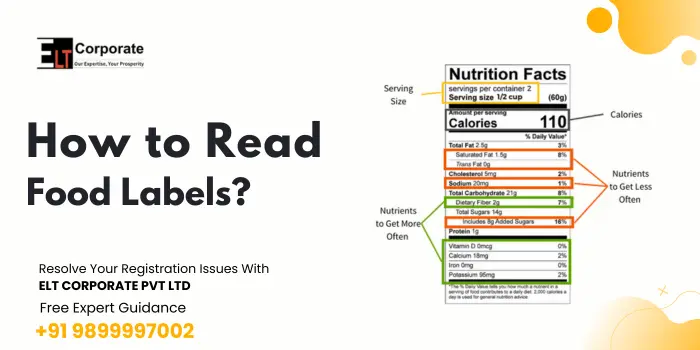Every time you pick up a packet of chips, cookies, or even your favourite instant noodles, a small label is printed on the back side of the product. While it might look boring or complex, that little label holds valuable insights about what you’re about to eat. Food labels are more than just fine print; they tell us about the ingredients, nutrients, and hidden elements like added sugars or preservatives. In a world full of catchy advertisements and health claims, learning how to read these labels helps you make informed, safe, and healthy food choices. This blog will benefit you by helping you to understand how not to get tricked by food labels and make smarter eating decisions.
What is a Food Label, And Why Is Reading Food Labels Important?
A food label is needed to provide information about the nutritional value, ingredients, origin, and manufacturer of a packaged food product. Reading food labels is important because:
- It helps monitor calorie intake and manage health conditions like diabetes or hypertension.
- Alerts you to allergens and additives that may affect your health
- Allows you to compare products and choose the most nutritious options.
Knowing food labels ensures you’re not just trusting advertising claims but verifying them with facts.
How To Read Food Labels And Find Key Information On a Package?
Food labels effectively, look for the following sections on the labels:
- Nutrition Facts Table – Normally on the back or side of the packet.
- Ingredients List – Found below or beside the nutrition facts.
- FSSAI License Number – Verifies that the product is approved.
- MRP, Net Quantity, Date of Manufacturing & Expiry – Found at the bottom or corner of the label.
- Country of Origin – Important for imported food.
How To Read The Nutrition Facts Table on Food Labels?
To read the nutrition facts table on the food labels, you can check out the mentioned points:
- Calories – check the calories per serving and compare them with how much you eat. If you eat 2 servings, you’re consuming double the calories listed.
- Macronutrients – Fats (Including saturated and trans). Carbohydrates, including sugar, and proteins.
- Micronutrients – Vitamins and minerals like calcium, iron, vitamin D, and potassium that support bones, blood, and energy.
- % Daily Value (%DV) – 5% or less = low, 20% or more = high. Use this to check whether the food is high or low in key nutrients like fiber and sodium.
How Food Labels Can Be Misleading?
According to the National Institute on Aging (NIA), the terms “natural,” “fat-free,” and “whole grain” are mostly used to attract buyers, but the actual product might still contain added sugar, saturated fats, or excess sodium. So, it’s better to always look for the Nutrition Facts and Ingredients list, not just claims on the front of the pack.
Which Ingredients Should You Watch Out For While Reading Food Labels?
There are some ingredients present in the product that you should know before consuming it, as they are legal but not good for your health. Ingredients like:
Hidden Sugars – Like High fructose corn syrup, maltose, dextrose.
Unhealthy Fats– Hydrogenated oils and trans fats raise cholesterol.
Artificial Additives – Flavor, colors, and preservatives (such as E102, E621).
Sodium/Salt – High sodium intake is linked to high blood pressure.
The NIA advises keeping an eye on these red flags, nutrients, especially if the % Daily value is over 20%, which is considered high. Aim for 5% or less in these cases for safer choices.
How Food Labels Can Be Misleading?
Marketing terms can be deceptive. For example:
- Sugar-Free
- Fat-Free
- Natural
Always check nutrition facts and ingredients lists over front-of-pack claims.
How To Read The Ingredients List VS Nutrition Facts on the Food Labels?
Check the table to know the difference between the ingredient list and nutrition facts on the food labels:
| S.No. | Features | Ingredients List | Nutrition Facts |
|---|---|---|---|
| 1. | Purpose | Shows what the food is made of | Shows the nutritional content for a serving |
| 2. | Order | Ingredients are mentioned in descending order by weight | Fixed layout (Calories, Macronutrients, %DV) |
| 3. | Focus | Identifies additives, allergens, and base ingredients | Highlights energy, fats, sugar, protein, and vitamins |
| 4. | Use Case | Helps avoid harmful or excessive additives | Helps assess if the food meets dietary needs. |
| 5. | Format | Text-based list | Tabular or box format |
Why Reading Country of Origin And Expiry Date On Food Labels Matters?
It is important to check the country of origin and expiry date on food labels because:
Country of Origin – Ensures you’re aware of where the product is coming from, mainly for importing subjects to different safety standards.
Expiry Date – Prevents consumption of expired or near-expiry products.
What are India’s Legal Rules For Food Labels?
In India, food labels should comply with FSSAI guidelines. It includes:
- Display of nutrition facts and ingredients list.
- Declaration of allergens and vegetarian/non-vegetarian symbols.
- Manufacturers/importers’ details and FSSAI license number.
- Net weight, MRP, date of manufacture, and expiry.
Understanding these rules in detail helps you to choose the right product for you and your loved ones.
Why Trust ELT Corporate?
ELT corporate is India’s leading regulatory consultancy, expertised in certifications like FSSAI, LMPC, BIS, and many more. We assist brands in complying with legal standards and labelling norms, making sure your products follow both Indian and global regulatory requirements.
- Expert guidance from regulatory professionals.
- End-to-end assistance for certification and compliance
- Hassle-free documentation and fast approvals
- Trusted by hundreds of importers, manufacturers, and startups
To get in touch with experts at ELT Corporate, call 9899997002 for end-to-end compliance solutions.
What is the First Thing To Check on A Food Label?
First, you have to check the nutrition facts table and then the serving size to understand the calorie and nutrient content.
How Can I Know If A Food is Healthy by Reading the Label?
Check the %DV if sodium, saturated fat, or added sugars are 20% or higher, it’s best to skip or consume in moderation. If fiber, vitamin D, or calcium are high, that is a positive sign.







